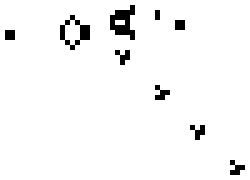Building a Game of Life Simulation in Lua
Introduction
The Game of Life, invented by John Conway, is a fascinating simulation that illustrates how complex patterns can emerge from simple rules.
In this post, I’ll guide you through creating a Game of Life simulation using Lua, where each cell follows basic rules for birth, survival, and death.
Lua’s simplicity makes it a great language for small-scale simulations like this.
We’ll take user input for grid density and the number of generations, simulate the evolution of the grid, and print the results right in the terminal.
What is the Game of Life?
For those not familiar, Conway’s Game of Life is computer graphical simulation based on cellular automation.
Every cell interacts with its eight neighbors, which are the cells that are horizontally, vertically, or diagonally adjacent.
At each step in time, the following transitions occur:
- Any live cell with fewer than two live neighbours dies, as if by underpopulation.
- Any live cell with two or three live neighbours lives on to the next generation.
- Any live cell with more than three live neighbours dies, as if by overpopulation.
- Any dead cell with exactly three live neighbours becomes a live cell, as if by reproduction.
Setting up the Universe
We first initialize a 50x50 universe grid, N and M, and an empty array uni that will represent our universe’s state.
Each cell will either be “alive” (X) or “dead” ( ).
A directional array dir is used to check neighboring cells for each position.
local N = 50
local M = 50
local uni = {}
-- Directional array that allows a cell to check nearby neighbors
local dir = {
{-1, -1}, {0, -1}, {1, -1},
{1, 0}, {1, 1},
{0, 1}, {-1, 1}, {-1, 0},
}Getting User Input
We get user input for the initial density of the universe and the number of generations.
The density controls how likely each cell starts as alive.
If you want to experiment with various setups, adjusting the density can drastically change the evolution patterns.
local function getUserInputDensity()
local density
while true do
io.write("Universe Density (Float between 0 and 1): ")
density = io.read()
density = tonumber(density)
if density == nil or density < 0 or density > 1 then
print("Please enter a valid number between 0 and 1.")
else
break
end
end
io.write("Selected density: ", density, "!\n")
return density
end
local function getUserInputGeneration()
local generations
while true do
io.write("Number of Generations (positive integer): ")
generations = io.read()
generations = tonumber(generations)
if generations == nil or generations <= 0 then
print("Please enter a valid number greater than 0.")
else
break
end
end
io.write("Selected generations: ", generations, "!\n")
return generations
end
Creating the Universe
The newUniverse function generates the grid based on the chosen density.
Each cell is randomly initialized as either alive (X) or dead ( ), based on the density parameter.
local function newUniverse(density)
local newUni = {}
for x = 1, N do
newUni[x] = {}
for y = 1, M do
if math.random() < density then
newUni[x][y] = "X"
else
newUni[x][y] = " "
end
end
end
return newUni
endCounting Neighbors
For each cell in the universe, we need to count its alive neighbors.
This function uses our directional array to check neighboring cells.
local function countNeighbors(universe, x, y)
local count = 0
for i = 1, #dir do
local row = (x + dir[i][1] - 1) % N + 1
local col = (y + dir[i][2] - 1) % M + 1
if universe[row][col] == "X" then
count = count + 1
end
end
return count
endUpdating the Universe
Reminder, the rules of Conway’s Game of Life are simple:
- A cell with fewer than 2 or more than 3 neighbors dies (under/overpopulation).
- A cell with exactly 3 neighbors is born.
- A cell with 2 or 3 neighbors survives to the next generation.
We apply these rules to create a new universe with updated states.
local function updateUniverse(universe)
local newUni = {}
for x = 1, N do
newUni[x] = {}
for y = 1, M do
local neighbors = countNeighbors(universe, x, y)
local cell = universe[x][y]
if cell == "X" then
if neighbors < 2 or neighbors > 3 then
newUni[x][y] = " " -- cell dies
else
newUni[x][y] = "X" -- cell survives
end
else
if neighbors == 3 then
newUni[x][y] = "X" -- new cell is born
else
newUni[x][y] = " "
end
end
end
end
return newUni
endPrinting the Universe
Lastly, we print the universe in the terminal after each generation.
This is a simple visual representation, where each X represents a living cell.
local function printUniverse(universe)
for x = 1, N do
for y = 1, M do
io.write(universe[x][y] .. " ")
end
print()
end
endRunning the Simulation
We initialize the universe with user-defined density and run it for the specified number of generations, updating the grid and printing it after each step.
local density = getUserInputDensity()
uni = newUniverse(density)
local generations = getUserInputGeneration()
for gen = 1, generations do
print("Generation:", gen)
printUniverse(uni)
uni = updateUniverse(uni)
endConclusion
This basic Game of Life simulation in Lua is a great way to experiment with how patterns emerge from simple rules.
Lua’s flexibility and easy-to-read syntax make it perfect for small simulations like this, allowing you to focus on logic rather than complexity.
Written By Nick Stambaugh
